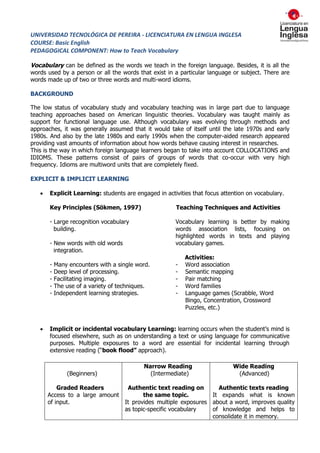
TEFL Vocabulary Teaching Methods
- 1. UNIVERSIDAD TECNOLÓGICA DE PEREIRA - LICENCIATURA EN LENGUA INGLESA COURSE: Basic English PEDAGOGICAL COMPONENT: How to Teach Vocabulary Vocabulary can be defined as the words we teach in the foreign language. Besides, it is all the words used by a person or all the words that exist in a particular language or subject. There are words made up of two or three words and multi-word idioms. BACKGROUND The low status of vocabulary study and vocabulary teaching was in large part due to language teaching approaches based on American linguistic theories. Vocabulary was taught mainly as support for functional language use. Although vocabulary was evolving through methods and approaches, it was generally assumed that it would take of itself until the late 1970s and early 1980s. And also by the late 1980s and early 1990s when the computer-aided research appeared providing vast amounts of information about how words behave causing interest in researches. This is the way in which foreign language learners began to take into account COLLOCATIONS and IDIOMS. These patterns consist of pairs of groups of words that co-occur with very high frequency. Idioms are multiword units that are completely fixed. EXPLICIT & IMPLICIT LEARNING Explicit Learning: students are engaged in activities that focus attention on vocabulary. Key Principles (Sökmen, 1997) Teaching Techniques and Activities - Large recognition vocabulary building. Vocabulary learning is better by making words association lists, focusing on highlighted words in texts and playing vocabulary games. - New words with old words integration. - Many encounters with a single word. Deep level of processing. Facilitating imaging. The use of a variety of techniques. Independent learning strategies. - Activities: Word association Semantic mapping Pair matching Word families Language games (Scrabble, Word Bingo, Concentration, Crossword Puzzles, etc.) Implicit or incidental vocabulary Learning: learning occurs when the student’s mind is focused elsewhere, such as on understanding a text or using language for communicative purposes. Multiple exposures to a word are essential for incidental learning through extensive reading (“book flood” approach). (Beginners) Narrow Reading (Intermediate) Wide Reading (Advanced) Graded Readers Authentic text reading on Authentic texts reading Access to a large amount the same topic. It expands what is known of input. It provides multiple exposures about a word, improves quality as topic-specific vocabulary of knowledge and helps to consolidate it in memory.
- 2. VOCABULARY ASPECTS OF MEANING 1. Denotative and Connotative Meaning: It concerns the link between meaning and the world to which word refers. A word can have many different meanings according to the context where it is used. Denotative or referential meaning: The primary or basic meaning of a word. Example: Heart (organ): The organ that sends the blood around your body. He’s got a weak heart. Connotative Meaning: The secondary meanings of a word. Example: Heart (emotion): used to refer to a person’s character. She has a good heart. 2. Meaning relations among words: The second aspect involves the sense relations that exist among words. These relations have two dimensions or axes: The Horizontal axis represents syntagmatic relations, those between items and sentences. It has to do with grammatical collocation or lexical collocation. Grammatical collocations are those in which noun, verb, or adjective frequently co-occur with a grammatical item, usually a preposition. Example: reason for, rely on, afraid of, account for. Lexical collocations include combinations of all lexical items such as: nouns, verbs, adjectives and adverbs. Example: verb + money = spend money, save money, steal money. The Vertical axis represents paradigmatic relations, the complex relationship that exists between items in the whole lexical system. Learning English means acquiring knowledge of synonyms, antonyms, and other relations in its semantic structure. VOCABULARY LEARNING STRATEGIES Strategies should aid to discover the meaning of a new word and to consolidate a word once it has been encountered. Guessing Meaning from Context: this strategy focuses mainly on context rather than looking at word parts. Mnemonic Devices: the learner chooses a word from the first language (keyword) which sounds like the new word in L2. The learner can make an association between the two of them. Vocabulary Notebooks: Students write word pairs and semantic maps to relate the new and familiar words. References: Based on the article Vocabulary Learning and Teaching, written by DeCarrico, J.S.